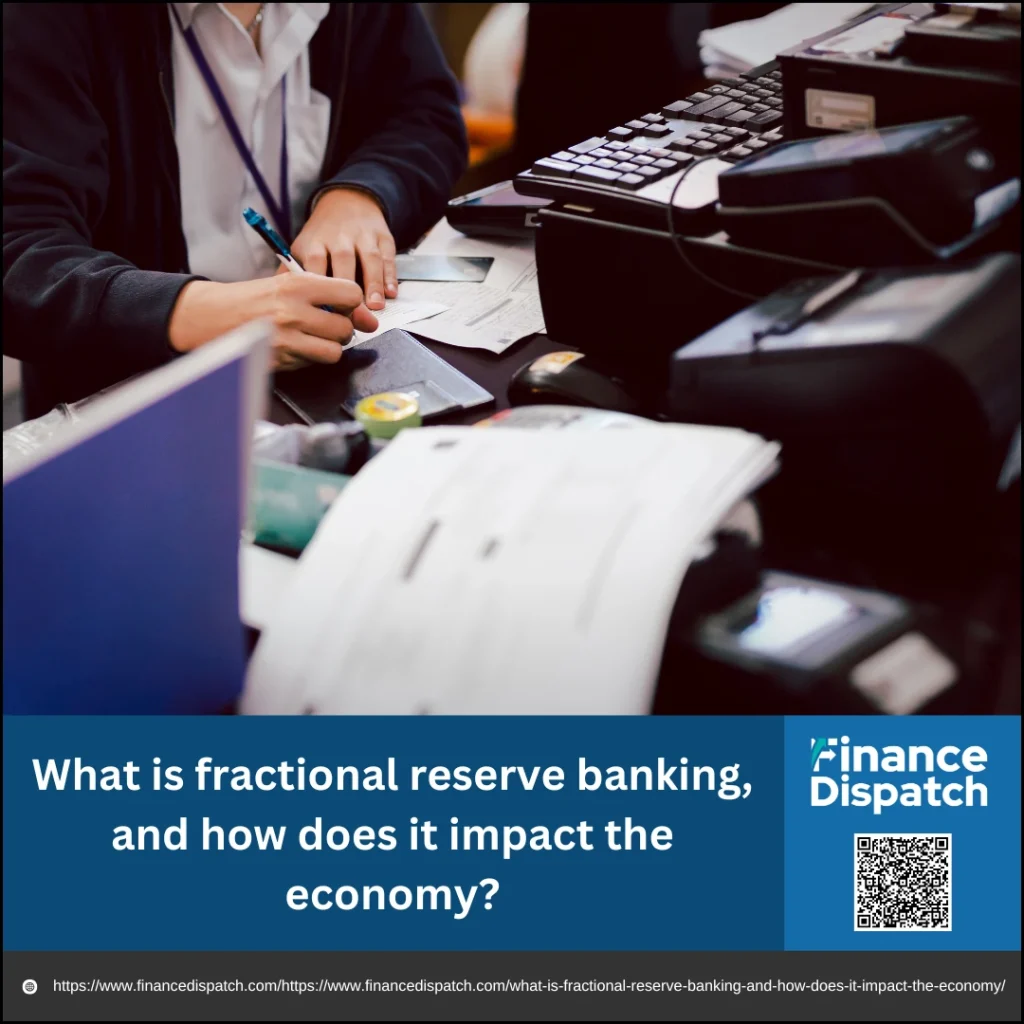Fractional reserve banking is a foundational element of modern financial systems, allowing banks to lend a portion of customer deposits while holding a fraction in reserve. This system not only fuels economic activity by increasing the availability of credit but also shapes how central banks implement monetary policy. While it promotes growth and liquidity in the economy, it also carries risks, particularly in times of financial stress. Understanding how fractional reserve banking works and its broader economic impact is essential for grasping how money circulates, how banks function, and how economies expand or contract in response to changing financial conditions.
What is Fractional Reserve Banking?
Fractional reserve banking is a system in which banks are required to keep only a small portion of their customers’ deposits as reserves, while the rest can be used to issue loans or make investments. For example, if a bank receives a $1,000 deposit and the reserve requirement is 10%, it must hold $100 in reserve and can lend out the remaining $900. This practice enables banks to create new money in the economy through lending, as the deposited funds are simultaneously recorded as liabilities for the bank and assets for the depositors. By allowing the same money to circulate multiple times, fractional reserve banking helps expand the money supply, encourage spending, and support economic growth.
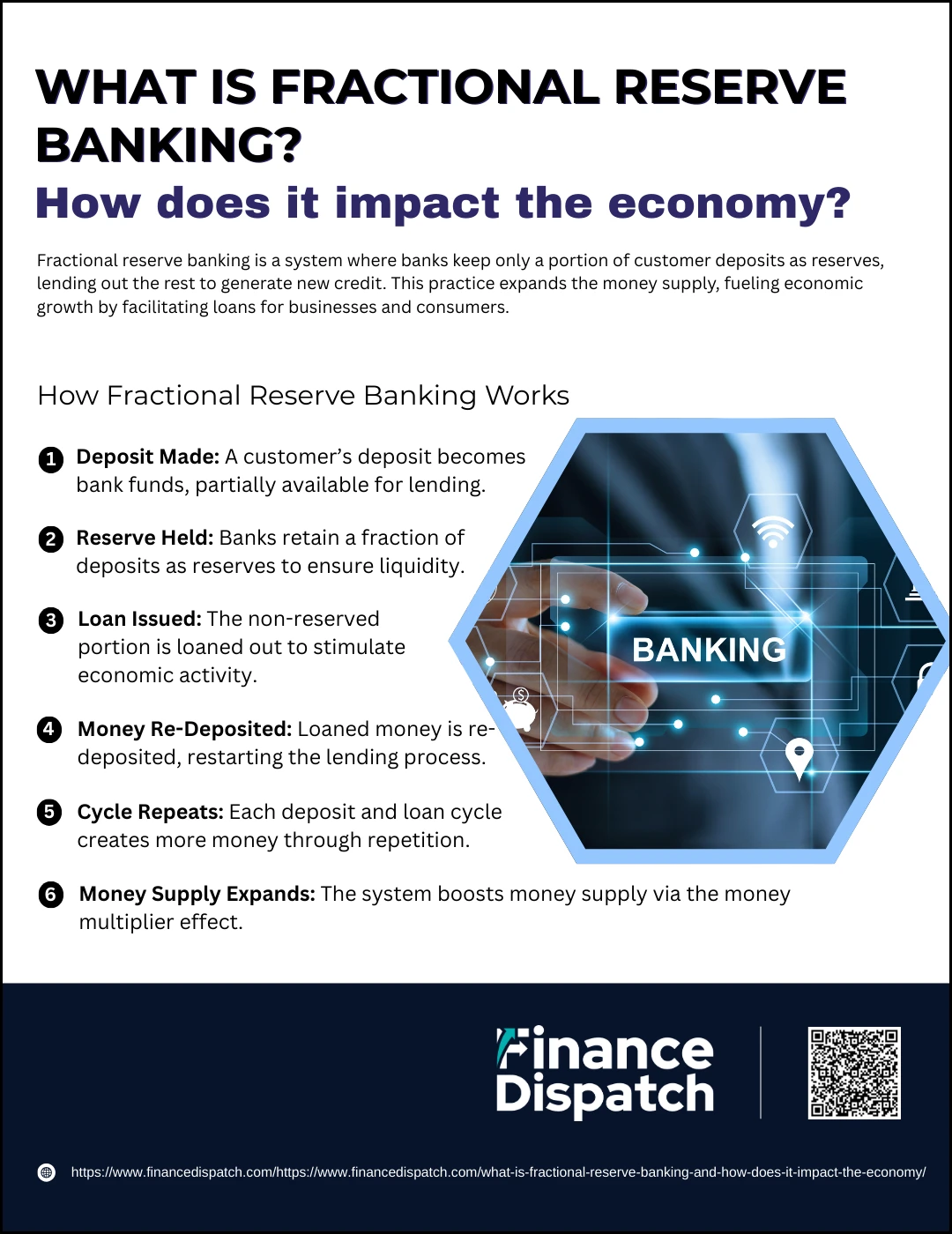 How Fractional Reserve Banking Works
How Fractional Reserve Banking Works
Fractional reserve banking is the backbone of modern financial systems. It enables banks to lend out a significant portion of the money deposited by customers while retaining only a small fraction as reserves. This not only maximizes the use of idle funds but also stimulates economic growth through increased lending. The process of money creation and circulation through this system follows a clear sequence of steps:
1. Deposit Made
A customer walks into a bank and deposits $1,000 into their savings or checking account. This deposit becomes part of the bank’s available funds. Although the customer sees the full amount in their account and can access it on demand, the bank is now allowed to use a large portion of it for other financial activities such as lending.
2. Reserve Held
To maintain stability and liquidity, banks are required by the central bank (e.g., the Federal Reserve in the U.S.) to hold a portion of each deposit as reserves. If the reserve requirement is 10%, the bank must keep $100 from the $1,000 deposit either in its vault or as a balance with the central bank. This reserve acts as a buffer to meet withdrawal demands and prevent liquidity crises.
3. Loan Issued
The remaining $900 (after setting aside the $100 reserve) is now available for the bank to lend to other customers. This loan could be used by an individual to purchase a car, start a small business, or pay for education. When the loan is issued, the money enters the economy, generating more financial activity and consumption.
4. Money Re-Deposited
The person or business that receives the $900 loan eventually deposits it into another bank account—either at the same bank or a different one. For instance, if the borrower uses the loan to pay a contractor, the contractor will likely deposit the funds into their bank account. This new deposit becomes the basis for another round of lending.
5. Cycle Repeats
The second bank will now hold 10% of the $900 as reserves ($90) and can lend out the remaining $810. This process continues with each new loan and deposit, creating a chain reaction of money creation. With each cycle, more money is introduced into the financial system, even though the actual physical cash remains the same.
6. Money Supply Expands
Through this repeating process, the total money circulating in the economy grows significantly—a phenomenon known as the money multiplier effect. Although only a portion of the original deposit was used at each step, the combined effect of multiple deposits and loans dramatically increases the total supply of money available for spending and investment.
Key Features of Fractional Reserve Banking
Fractional reserve banking is a system that allows banks to hold only a fraction of customer deposits in reserve while lending out the majority to individuals and businesses. This mechanism is central to how modern economies expand their money supply and support economic activity. While it offers various benefits, it also requires regulation and public confidence to function smoothly. Below are the key features that define this banking model:
1. Partial Reserve Requirement: Banks are required to keep only a specific percentage (e.g., 10%) of total deposits as reserves, allowing the rest to be used for lending and investments.
2. Credit Creation: By lending out deposited funds, banks effectively create new money in the economy, increasing the overall money supply without printing physical currency.
3. Interest Income: Banks earn profits by charging higher interest rates on loans than they pay on deposits, creating a spread that forms a major part of their income.
4. Liquidity Management: Banks must carefully manage their liquidity to ensure they have enough reserves to meet withdrawal demands while maximizing lending opportunities.
5. Role of Central Banks: Central banks regulate reserve requirements, offer emergency lending facilities, and influence interest rates to maintain financial stability within the system.
6. Risk of Bank Runs: Since not all deposits are held in cash, sudden mass withdrawals (bank runs) can lead to liquidity crises if confidence in the system falters.
7. Money Multiplier Effect: The repeated cycle of deposit-lend-deposit allows a single deposit to support a much larger volume of loans and deposits throughout the banking network.
8. Economic Stimulus: This system boosts economic growth by making more funds available for consumers, entrepreneurs, and businesses to borrow and spend.
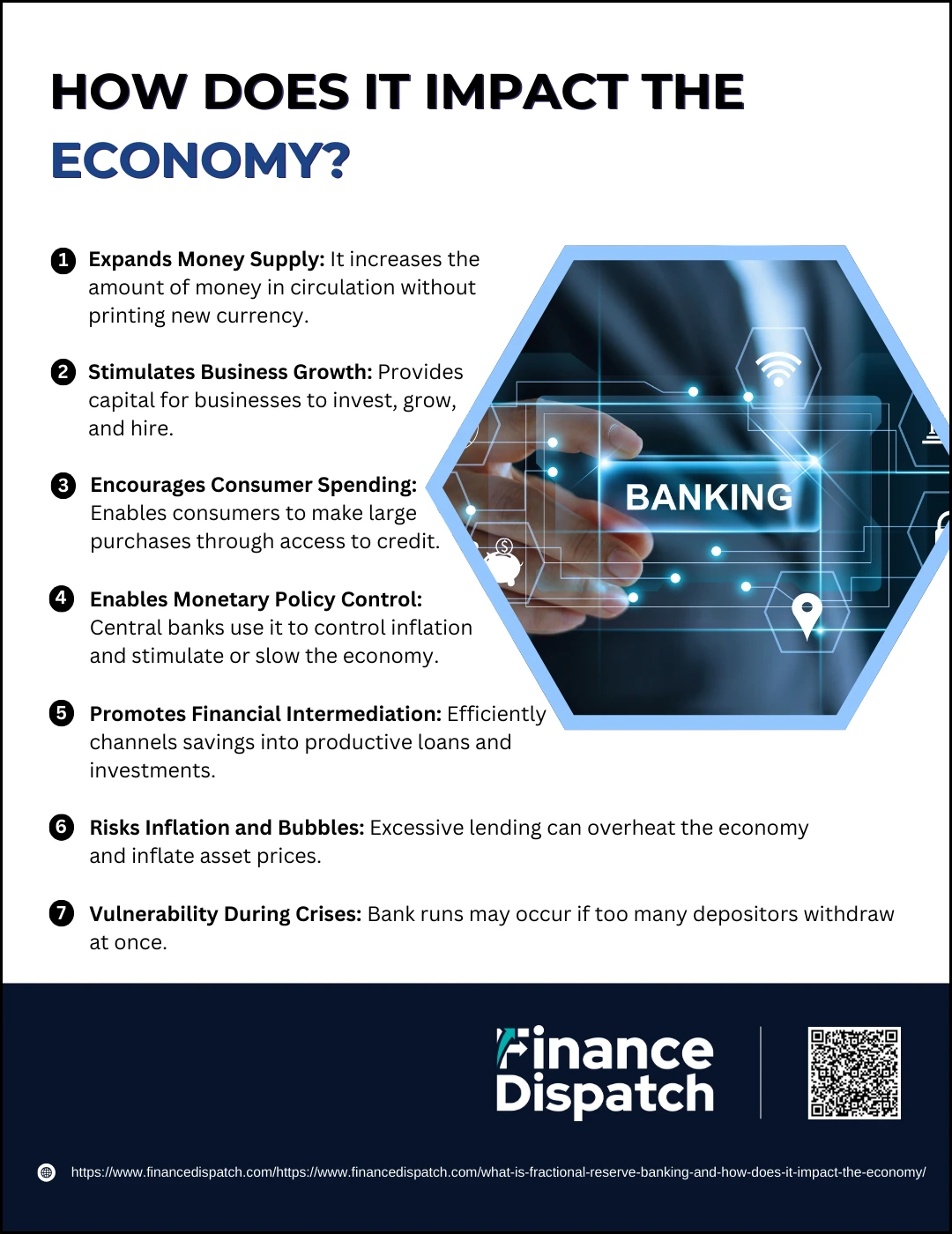 How Does It Impact the Economy?
How Does It Impact the Economy?
Fractional reserve banking is a powerful engine for economic growth and financial intermediation. By enabling banks to lend out a portion of deposits, this system supports a wide range of economic activities, from individual consumption to business expansion and government policy implementation. However, it also introduces vulnerabilities that must be carefully managed. Here’s a closer look at the key ways in which fractional reserve banking affects the broader economy:
1. Expands Money Supply
When a bank lends out deposits, the same money is effectively counted in two places: as the original depositor’s balance and as a loan to a borrower. This process, repeated across many banks and deposits, multiplies the amount of money circulating in the economy. Known as the money multiplier effect, it enhances liquidity and supports increased economic transactions without creating physical currency.
2. Stimulates Business Growth
Access to credit is vital for businesses to invest in new technologies, expand operations, and hire workers. Fractional reserve banking ensures that capital is not sitting idle in bank vaults but is instead actively flowing into productive ventures. This supports entrepreneurship, innovation, and long-term economic development, particularly in sectors that rely heavily on financing.
3. Encourages Consumer Spending
Loans made possible by fractional reserves enable consumers to finance large purchases—homes, cars, education—that they might not otherwise afford. As consumer demand increases, businesses see higher sales and may respond by expanding production, thereby creating a positive feedback loop that boosts GDP and employment.
4. Enables Monetary Policy Control
Central banks use fractional reserve banking as a lever to regulate the economy. By adjusting reserve requirements, interest rates, and offering lending facilities (like the discount window), they influence how much money banks can lend. For example, lowering reserve requirements or interest rates encourages borrowing and spending, while raising them can help control inflation during economic booms.
5. Promotes Financial Intermediation
Fractional reserve banking helps efficiently channel savings into investments. Banks act as intermediaries, taking funds from depositors who may not immediately need them and lending those funds to borrowers who require capital. This allocation improves overall economic efficiency by directing money to where it can generate the highest return.
6. Risks Inflation and Bubbles
If banks lend excessively without adequate oversight, the resulting surge in money supply can lead to inflation, where too much money chases too few goods. It can also inflate asset prices—such as in real estate or stock markets—creating speculative bubbles. When these bubbles burst, the resulting losses can trigger widespread economic downturns.
7. Vulnerability During Crises
Fractional reserve banking depends on depositor confidence. If people fear a bank’s insolvency, they may all try to withdraw their funds at once—a situation known as a bank run. Since banks don’t keep all deposits in reserve, they may be unable to meet the sudden demand, leading to closures and systemic risk. This is why regulations like deposit insurance (e.g., FDIC in the U.S.) and central bank support are crucial.
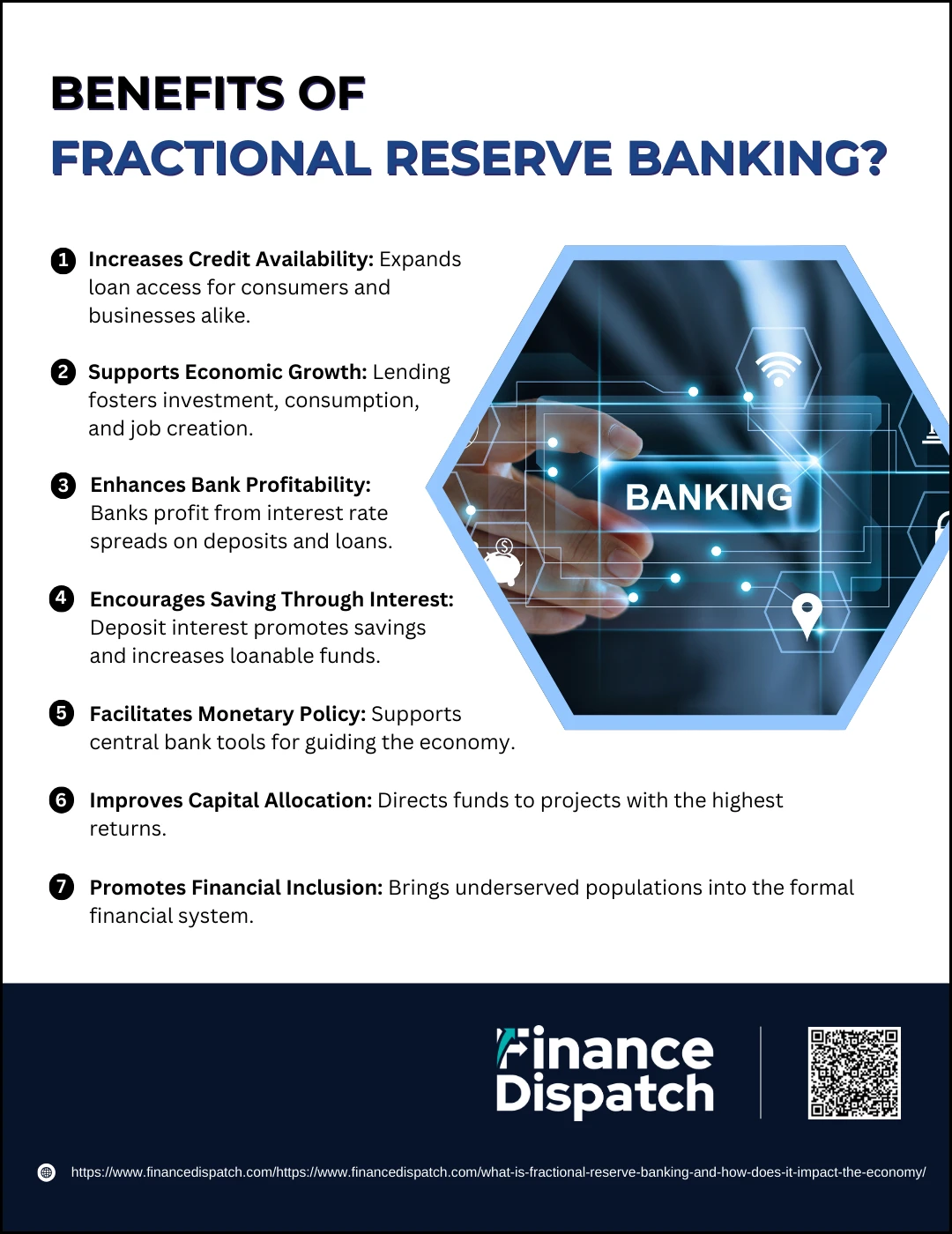 Benefits of Fractional Reserve Banking
Benefits of Fractional Reserve Banking
Fractional reserve banking is not just a method of managing deposits—it’s a dynamic tool that drives financial systems and economic progress. By lending a portion of deposited funds, banks stimulate spending, investment, and innovation. This system supports the financial needs of both individuals and businesses, all while giving central banks mechanisms to guide economic stability. Below are the key benefits of fractional reserve banking, explained in greater detail:
1. Increases Credit Availability
One of the most significant advantages of fractional reserve banking is that it makes credit widely accessible. When banks lend out a portion of customer deposits, they provide funding for mortgages, student loans, auto financing, and business expansion. This helps individuals and enterprises access resources they wouldn’t otherwise have, supporting financial mobility and entrepreneurship.
2. Supports Economic Growth
Lending drives economic activity. When businesses borrow money to invest in equipment, infrastructure, or hiring, they increase productivity and generate employment. Consumers, in turn, borrow for purchases like homes and cars, further stimulating demand. These actions collectively raise a country’s GDP and contribute to a growing, vibrant economy.
3. Enhances Bank Profitability
Banks earn a profit from the difference between the interest rates they pay on deposits and the interest they charge on loans. This model enables banks to grow sustainably, invest in infrastructure and technology, and offer better services to customers. Profitable banks also provide returns to investors and can support more loans in the future.
4. Encourages Saving Through Interest
Although banks use deposits to make loans, they compensate depositors with interest. This encourages people to save money rather than hoarding cash, increasing the pool of available funds that banks can use for lending. The cycle supports long-term financial planning and wealth-building for individuals.
5. Facilitates Monetary Policy
Fractional reserve banking gives central banks powerful tools to steer the economy. By adjusting reserve requirements or key interest rates, central banks can control the amount of money circulating in the economy. For instance, lowering reserve requirements or interest rates encourages lending and spending during economic downturns, while tightening them helps curb inflation during booms.
6. Improves Capital Allocation
Banks act as intermediaries that channel savings into productive uses. They assess creditworthiness and direct funds to projects and individuals that are most likely to yield returns. This effective allocation ensures that resources are used efficiently, fueling innovation, infrastructure, and industry in both emerging and developed markets.
7. Promotes Financial Inclusion
By expanding the availability of banking services and loans, fractional reserve banking helps bring more people into the financial system. Small businesses, low-income individuals, and rural communities gain access to essential services like credit, savings, and investment products—fostering inclusive economic development.
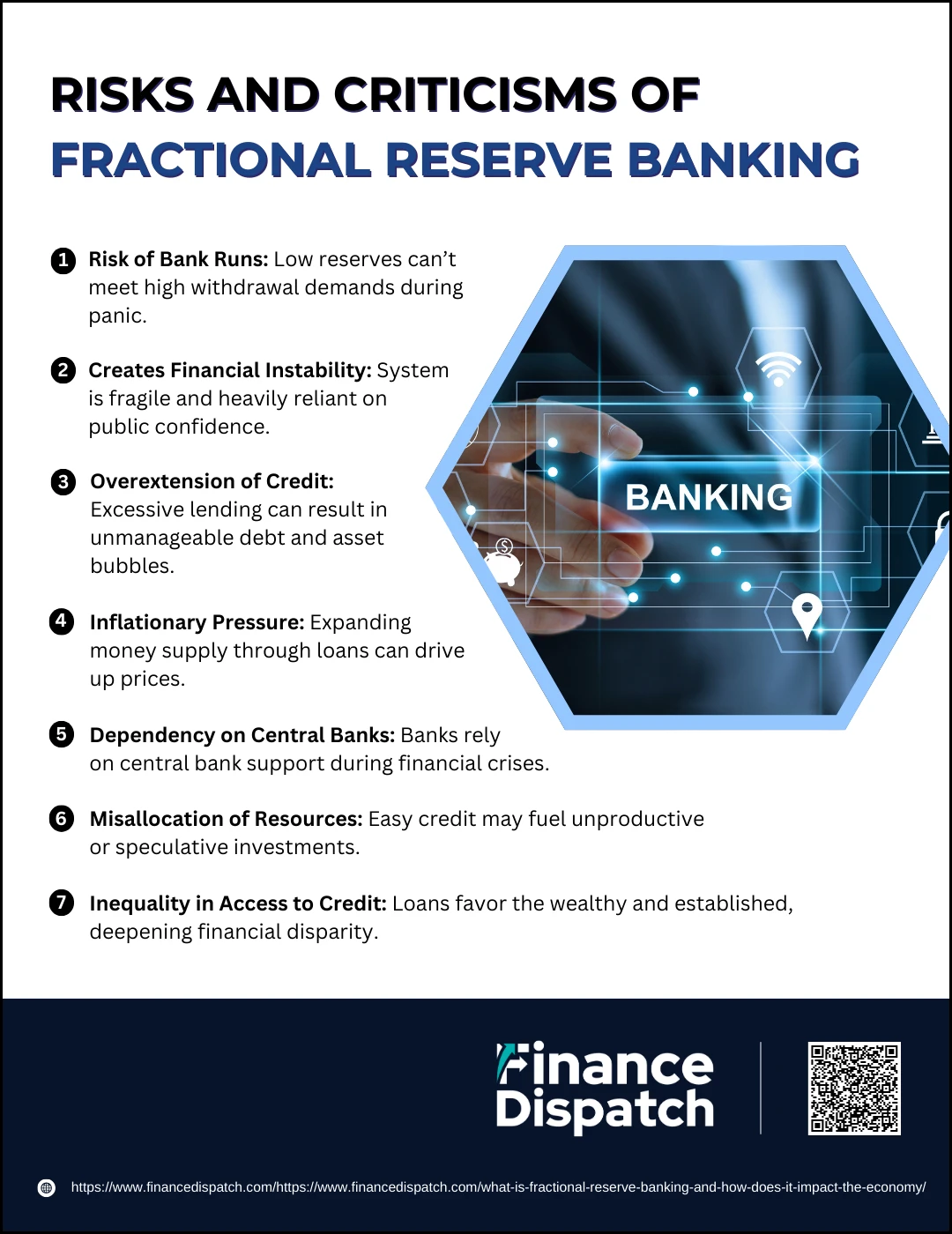 Risks and Criticisms of fractional reserve banking
Risks and Criticisms of fractional reserve banking
While fractional reserve banking supports economic expansion and financial intermediation, it is not without its flaws. The very mechanisms that allow banks to multiply money and increase credit availability can also lead to financial instability, particularly during times of economic stress or uncertainty. Critics argue that the system’s reliance on confidence and limited reserves makes it inherently fragile. Below are the key risks and criticisms associated with fractional reserve banking:
1. Risk of Bank Runs
Since banks keep only a fraction of deposits in reserve, they may not be able to fulfill all withdrawal requests if many customers demand their money at once. This phenomenon, known as a bank run, can cause banks to collapse and spark widespread panic in the financial system.
2. Creates Financial Instability
The system depends heavily on trust and stability. If confidence in the banking system is shaken—due to economic downturns, poor lending practices, or scandals—it can lead to rapid financial disruption, as seen during the Great Depression and the 2008 financial crisis.
3. Overextension of Credit
When banks aggressively lend out most of their deposits, it can lead to excessive borrowing and unsustainable debt levels. This overextension increases the risk of defaults and asset bubbles, which can have severe consequences for the economy when they burst.
4. Inflationary Pressure
By continuously expanding the money supply through loans, fractional reserve banking can contribute to inflation. If too much money chases too few goods, prices rise, reducing purchasing power and potentially destabilizing the economy.
5. Dependency on Central Banks
The system relies on central banks to act as lenders of last resort during crises. This dependence means that banks may take more risks, assuming they’ll be bailed out—an issue referred to as moral hazard.
6. Misallocation of Resources
Easier access to credit does not always lead to productive investments. Sometimes, it fuels speculative behavior, where money is funneled into high-risk ventures or non-essential consumption, diverting funds away from more sustainable, long-term uses.
7. Inequality in Access to Credit
Although fractional reserve banking is meant to promote financial inclusion, in reality, credit is often extended more readily to large corporations and high-income individuals than to small businesses or lower-income households, perpetuating economic inequality.
Historical Background of fractional reserve banking
The origins of fractional reserve banking can be traced back to the Middle Ages, when goldsmiths stored precious metals for safekeeping and issued paper receipts to depositors. Over time, these goldsmiths realized that not all depositors would claim their gold at the same time, allowing them to lend out a portion of the stored wealth while keeping enough in reserve to meet typical withdrawal demands. This practice laid the foundation for modern banking. In the United States, the system became formalized with the National Bank Act of 1863, which required banks to hold reserves to protect customer deposits. The establishment of the Federal Reserve in 1913 further shaped the system by granting a central authority the power to set reserve requirements and act as a lender of last resort. Over the years, the reserve ratios have fluctuated based on economic needs and monetary policy, culminating in a major shift in March 2020 when the reserve requirement was reduced to zero to increase lending capacity during the COVID-19 pandemic. This evolution reflects how fractional reserve banking has adapted to changing economic conditions while remaining central to financial systems worldwide.
Role of Central Banks in fractional reserve banking
Central banks play a crucial role in the functioning and regulation of fractional reserve banking systems. They establish reserve requirements, which determine the minimum fraction of customer deposits that commercial banks must hold in reserve. By adjusting these requirements, central banks can influence the lending capacity of banks and control the money supply. Additionally, central banks act as lenders of last resort, providing emergency liquidity to banks during financial crises to prevent systemic collapse. Through tools such as open market operations, the discount rate, and interest on reserve balances, central banks guide interest rates and maintain monetary stability. Their oversight ensures that while banks operate efficiently and profitably, they also maintain enough liquidity to meet withdrawal demands and support economic resilience.
Comparison: Fractional Reserve vs. Full Reserve Banking
Fractional reserve banking and full reserve banking represent two fundamentally different approaches to managing customer deposits and controlling money supply within the financial system. While fractional reserve banking allows banks to lend out a significant portion of deposits to stimulate economic growth, full reserve banking requires banks to keep 100% of deposited funds on hand, prioritizing stability and liquidity over expansion. Each system has its own advantages and limitations, depending on the goals of monetary policy and financial risk tolerance.
| Feature | Fractional Reserve Banking | Full Reserve Banking |
| Deposit Usage | A portion of deposits is held; the rest is lent out | 100% of deposits are held in reserve |
| Money Creation | Yes – through lending, new money is created | No – banks cannot create money through lending |
| Economic Growth Potential | High – boosts credit and stimulates economic activity | Limited – less credit availability may restrict growth |
| Risk of Bank Runs | Higher – limited reserves can lead to insolvency in a crisis | Lower – all deposits are always available for withdrawal |
| Regulation Dependency | High – relies on central bank oversight and policy tools | Lower – less reliance on active regulation for liquidity |
| Profitability for Banks | High – banks earn interest from loans using deposit funds | Lower – banks must find alternative ways to generate profit |
| Consumer Access to Loans | Broad – more loans available for consumers and businesses | Restricted – limited lending due to full reserve requirement |
| System Stability | Vulnerable to shocks without proper regulation | More stable but less flexible in supporting economic fluctuations |
| Usage in Modern Systems | Widely used around the world | Rarely used; mostly theoretical or proposed in economic reforms |
Real-World Examples of fractional reserve banking
Fractional reserve banking is the standard model used by most financial institutions across the globe. A common example can be seen in the United States, where commercial banks accept customer deposits and are permitted to lend out a significant portion while retaining only a small fraction as reserves. Before March 2020, U.S. banks were required to hold 10% of transaction account deposits, allowing them to use the remaining 90% for loans and investments. Although the reserve requirement was reduced to 0% during the COVID-19 pandemic to encourage lending and stimulate the economy, the practice of holding a fraction of reserves remains in effect operationally. Another example is seen in the eurozone, where the European Central Bank sets minimum reserve requirements for member banks. These real-world applications demonstrate how fractional reserve banking enables credit creation and economic expansion, while relying on strong regulatory frameworks and central bank support to maintain financial stability.
Conclusion
Fractional reserve banking is a foundational element of the modern financial system, enabling banks to support economic growth by lending out a portion of deposited funds. This system not only increases credit availability and stimulates investment but also allows central banks to influence monetary policy and stabilize the economy. However, it comes with inherent risks such as bank runs, over-lending, and financial instability if not properly regulated. Understanding how fractional reserve banking works—and its impact on consumers, businesses, and national economies—helps highlight the importance of balance between financial innovation and prudent oversight. As economies evolve, the system will continue to adapt, but its core principles remain central to how money moves and multiplies in the global economy.



